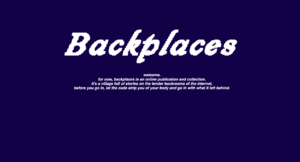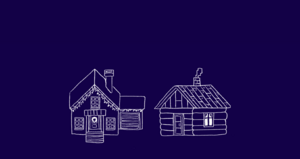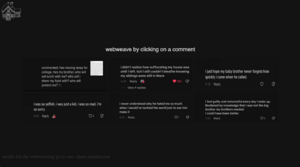User:Ada/Projectproposal: Difference between revisions
No edit summary |
No edit summary |
||
| Line 6: | Line 6: | ||
// [[User:Ada/Graduation|home]] | // [[User:Ada/Graduation|home]] | ||
==<span style="color: black; font-family: Menlo; text-decoration:none; background-color: #F4F2ED; padding-top: 0.1vw; padding-bottom: 0.1vw; padding-left: 0.1vw; padding-right: 0.2vw;"> ⊹ ࣪ ˖ w''hat do you want to make?'' </span>== | ==<span style="color: black; font-family: Menlo; text-decoration:none; background-color: #F4F2ED; padding-top: 0.1vw; padding-bottom: 0.1vw; padding-left: 0.1vw; padding-right: 0.2vw;"> ⊹ ࣪ ˖ w''hat do you want to make?'' </span>== | ||
[[File:Screenshot 2023-11-21 at 14.55.54.png|thumb|homepage trial!]]'''''Backplaces''''' is a digital collection that explores the stories of people seeking refuge in the hidden corners of the internet, where societal outcasts come together to find solace and understanding. It's a web anthology made of stories, poems, and love letters from these places. It's a heartfelt tribute to the groups, forums, and connections providing care and understanding to those marginalised in their daily lives. | |||
The collection explores the dynamics of online anonymity, revealing how it nurtures vulnerability. It sheds light on the misuse of web frameworks to construct personal narratives and goes into the deep connections formed by those marginalised in their physical existence. Rooted in messages, survey responses, notes, and comments from these online communities, both my own and others. [[File:Screenshot 2023-11-21 at 14.56.24.png|thumb|the village if you scroll down]] | |||
The collection explores the dynamics of online anonymity, revealing how it nurtures vulnerability. It sheds light on the misuse of web frameworks to construct personal narratives and goes into the deep connections formed by those marginalised in their physical existence. Rooted in messages, survey responses, notes, and comments from these online | |||
==<span style="color: black; font-family: Menlo; text-decoration:none; background-color: #F4F2ED; padding-top: 0.1vw; padding-bottom: 0.1vw; padding-left: 0.1vw; padding-right: 0.2vw;"> ⊹ ࣪ ˖ w''hy do you want to make it?'' </span>== | ==<span style="color: black; font-family: Menlo; text-decoration:none; background-color: #F4F2ED; padding-top: 0.1vw; padding-bottom: 0.1vw; padding-left: 0.1vw; padding-right: 0.2vw;"> ⊹ ࣪ ˖ w''hy do you want to make it?'' </span>== | ||
| Line 27: | Line 26: | ||
I will research web collections and word-based web art as I develop, as that is the form I've used so far to tell the stories on the collection. I expect the research I've done so far to inform where to go next. | I will research web collections and word-based web art as I develop, as that is the form I've used so far to tell the stories on the collection. I expect the research I've done so far to inform where to go next. | ||
'''[development]''' | '''[development]'''[[File:Screenshot 2023-11-21 at 15.03.59.png|thumb|an example of one of the house-webpages]]'''''Backplaces''''' is structured pretty simply as a digital village accessible through the main homepage. From there there will be little house illustrations that are hyperlinks to other html pages composing the collection. To make it I will keep on working on both the homepage and the separate stories which currently exist as html pages. | ||
'''''Backplaces''''' is structured pretty simply as a digital village accessible through the main homepage. From there there will be little house illustrations that are hyperlinks to other html pages composing the collection. To make it I will keep on working on both the homepage and the separate stories which currently exist as html pages. | |||
'''''part b:''''' storytelling | '''''part b:''''' storytelling | ||
Revision as of 15:09, 21 November 2023
// home
⊹ ࣪ ˖ what do you want to make?
Backplaces is a digital collection that explores the stories of people seeking refuge in the hidden corners of the internet, where societal outcasts come together to find solace and understanding. It's a web anthology made of stories, poems, and love letters from these places. It's a heartfelt tribute to the groups, forums, and connections providing care and understanding to those marginalised in their daily lives. The collection explores the dynamics of online anonymity, revealing how it nurtures vulnerability. It sheds light on the misuse of web frameworks to construct personal narratives and goes into the deep connections formed by those marginalised in their physical existence. Rooted in messages, survey responses, notes, and comments from these online communities, both my own and others.⊹ ࣪ ˖ why do you want to make it?
My life story may be mine alone, but my emotions are a shared experience. Like thousands of others, I've sought refuge in digital spaces during the darkest times. Virtual communities provided me with sincere feelings of belonging and were significant for my healing process. They were my first encounters with companionship and understanding, and they remain crucial witnesses to certain aspects of my identity. I'm not alone in this; I've personally witnessed the remarkable transformations these communities can bring, shaping identities and offering solace to those often marginalised in their physical world.
In today's internet landscape, these communities are rare and elusive, accessible only to internet users with the will to dig deep. They navigate around the technical frameworks set up by programmers, designers, and product owners, creatively evading censorship and repurposing spaces. They still exist and thrive because humans will always find ways to make non-human landscapes human-friendly—filled, which is to say filled with care, softness, and honesty.
This project is a tribute to these communities, crafted with respect and gentleness to acknowledge the digital connections that have meant so much to me. It's also for those who haven't experienced this kind of connection, offering an ethnographic study from within to truthfully portray this invisible love.
⊹ ࣪ ˖ how do you plan to make it?
part a : technical infrastructure
[research]
I will research web collections and word-based web art as I develop, as that is the form I've used so far to tell the stories on the collection. I expect the research I've done so far to inform where to go next.
[development]Backplaces is structured pretty simply as a digital village accessible through the main homepage. From there there will be little house illustrations that are hyperlinks to other html pages composing the collection. To make it I will keep on working on both the homepage and the separate stories which currently exist as html pages.part b: storytelling
[writing]
At the same time I will do non-coding work by processing and writing the data I have. This consists of the answers from two survey I ran on reddit, a very long collection of messages and comments from these backrooms and an interview with a digital literature club founder. Before these things become webpages they will be processed and made into their own little projects.
⊹ ࣪ ˖ what is your timetable?
December / January Overall Infrastructure
- Review relevant literature on online communities, digital storytelling, and the impact of anonymity.
- Test individual webpages for user navigation and readability.
- Finalise project architecture, testing different user pathways.
- Experiment with storytelling techniques, using both coding and traditional writing.
February / March / April Technical Testing Fun Time
- Less theory research, mostly technical research on these projects and how they run and are programmed
- Make even more digital and physical prototypes of the collection components themselves
- Continuously test and gather feedback on the collection from my classmates, teachers and friends
- Develop the platform and stories iteratively based on feedback.
May / June Design and Production
- Review and refine project elements.
- Fix mistakes and make new ones.
- Prepare for the graduation show by finding the presentation setup.
⊹ ࣪ ˖ who can help you and how?
👐🏽 I have received but will need more of the help and support of people in these backdoor online communities. I have found people to be less willing to talk about it to my body and more willing to talk about it to my computer so I will keep on doing that. These people will be kept fully anonymous and if any detail about them is shared it will be altered to protect their identity.
👐🏽 I've contacted Kendal a previous XPUB student, as her graduation project also explored online places. We are trying to find some sort of time for her to tell me how her project evolved to a phd project.
👐🏽 I am trying to find someone who has experience with building this kind of platform and ask them practical questions.
👐🏽 To prevent issues with me feeling insecure about my skills as a programmer I will keep showing my other xpubs what I'm doing and ask them to be nice and help if needed; especially if I start taking myself too seriously.
⊹ ࣪ ˖ relation to previous practice
This project borrows from a lot of the frameworks I've used before. I started my practice in the purely scientific field of communication science, but my interest in marginalised groups drove me to write my thesis about LGBTQ people and how represented they felt by mainstream media.
Once I joined XPUB, I felt a bit lost on how to connect my background in data research to art and design practices again. For my first project, I was part of the Garden Leeszaal project where I archived what people made in the workshop by scanning it and then bound it into a book. I didn't see it then, but now I know that my interest was ultimately in how people interacted with the books we provided and in recording their presence.
I felt more at home in our second project, where we made an healing toolkit. My personal interpretation of healing was Oracolotto, a deck of tarot cards based on my cultural heritage and dream interpretation. My personal conception of spirituality was and still is profoundly impacted by my own Italian esoteric heritage.
My last project was a web-based video calling platform recreating the feeling of a call with a switchboard operator. It connected only two computers at a time and was specifically made to contact XPUB from New York, where I was. It was part of a process of contextualising modern technology by learning what came before it and questioning why things are they way they are now. This brought me to think of the possibility of personalising web-based interaction by rethinking social platforms.
⊹ ࣪ ˖ relation to a larger context
This project draws inspiration from a diverse body of research, reflecting the fundamental role of the internet in the lives of marginalised people (Gonzales, 2015; Mesch, 2011). It uses conceptions and past studies on people who sat outside the norm in their communities and formed digressive digital communities (Adler & Adler, 2008; Smith & Wickes, 2013). In finding the stories and the people I used conceptions of virtual communities from The Government Lab (2020) which underline the power of virtual communities in nurturing mutual care, belonging, and shared experiences. To identify whether the people I was talking to/about were marginalised I used Mowat's conceptualisation of marginalisation (2015), emphasising inclusivity and acceptance.
For the technical background my work borrows from the way Tiny Awards celebrates a small, playful and heartfelt web. I was also inspired by the html review, an annual literature journal made to exist on the web. I also take more and more from the Net Art Anthology made by Rhizome, a collection of digital art.
In general, Backplaces relates to any piece of work that saw relational healing as possible, community as necessary and the really delicate matter of belonging and mutual care as the most important thing there is. It meets other projects on that plane of hidden web that one can only find by spending a long time online and by desperately needing to see and be seen, to hear and be heard, to love and be loved back.
⊹ ࣪ ˖ references
Adler, P.A. and Adler, P. (2008) ‘The Cyber Worlds of self-injurers: Deviant communities, relationships, and selves’, Symbolic Interaction, 31(1), pp. 33–56. doi:10.1525/si.2008.31.1.33.
Gonzales, A.L. (2015) ‘Disadvantaged minorities’ use of the internet to expand their social networks’, Communication Research, 44(4), pp. 467–486. doi:10.1177/0093650214565925.
The Government Lab (2020) The power of virtual communities, The GovLab. Available at: https://virtual-communities.thegovlab.org/ (Accessed: 28 September 2023).
Mesch, G.S. (2011) ‘Minority status and the use of computer-mediated communication’, Communication Research, 39(3), pp. 317–337. doi:10.1177/0093650211398865.
Mowat, J.G. (2015) ‘Towards a new conceptualisation of Marginalisation’, European Educational Research Journal, 14(5), pp. 454–476. doi:10.1177/1474904115589864.
Smith, N., Wickes, R. and Underwood, M. (2013) ‘Managing a marginalised identity in pro-anorexia and fat acceptance cybercommunities’, Journal of Sociology, 51(4), pp. 950–967. doi:10.1177/1440783313486220.



